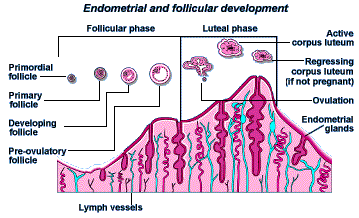The following is a break down of the four phases of a menstrual cycle.
The Menstrual Phase:
On Day 1, the menstrual period begins. Every month a woman's body builds up a fresh lining of tissue in the uterus in response to increasing amounts of the reproductive hormones estrogen and progesterone. If a woman is not pregnant, the levels of these two hormones decline. When these hormone levels have fallen to their lowest point, the lining, which is known as the endometrium, is shed from the uterus, through the cervix, vagina and out the vaginal opening. An average period lasts between 3 and 7 days.
The Pre-Ovulatory (Follicular) Phase:
As estrogen levels begin to fall during the few days prior to the onset of menstrual flow, an increase of follicle-stimulating hormone (FSH) is triggered. This, in turn, stimulates the growth of ovarian follicles. Each follicle contains an egg. Every month, FSH initiates and promotes the growth of a group of follicles. Soon, one or two follicles assume dominance, continuing to grow, mature and produce estrogen. The lining of the uterus begins to thicken in response to this increase in estrogen. Estrogen levels rise dramatically during the few days preceding ovulation. This is a signal that a mature follicle is ready to ovulate. The high levels of estrogen trigger the luteinizing hormone, or LH surge from the pituitary gland.
Over the course of a lifetime, a woman releases about 500 eggs in their mature form. The number of eggs that are contained in the ovaries depends on the age of the woman. The highest number is actually found before a girl is born. While still in the mother's uterus, a 20-week-old female fetus has approximately 7 million eggs. At birth, the number has decreased to 2 million. By the time a girl enters puberty, she has between 300,000 and 500,000 eggs. This decline in number is the process called atresia, a natural and continuous process that is uninterruptable. Only between 400 and 500 will ripen into mature eggs during a lifetime.

The Ovulation Phase:
The increase in luteinizing hormone (LH) triggers ovulation. Ovulation is an event that occurs when a mature egg is released from an ovarian follicle to the nearest fallopian tube. Fertilization, the union of an egg and sperm, occurs in the fallopian tube. The egg, fertilized or not, then travels into the uterus.
At ovulation, in addition to estrogen, progesterone is now produced. These two hormones combined stimulate the dramatic changes in the endometrium that are necessary to allow a pregnancy to implant and grow. In a woman who has regular 28 day cycles, ovulation usually occurs on day 14. However, most women have different cycle lengths. In general, ovulation occurs 11-16 days before your upcoming period.
The Premenstrual (Luteal) Phase:
After ovulation, the follicle becomes the corpus luteum. The cells of the corpus luteum produce estrogen and progesterone and these two hormones are involved in the development of the uterine lining. If a woman does not become pregnant, the corpus luteum regresses about two weeks after ovulation. Because of this, estrogen and progesterone levels drop and the stimulation for the endometrium is lost. This causes the shedding of the lining to begin, and a new menstrual cycle commences.
If a woman becomes pregnant during a menstrual cycle, fertilization will occur within 24 hours after ovulation. Five days after fertilization, the embryo (fertilized egg) enters the uterus and becomes embedded in the endometrium a few days later. With implantation, cells that will eventually become the placenta begin to produce human chorionic gonadotropin (HCG), which is sometimes called the "pregnancy hormone." HCG interrupts the menstrual cycle by providing continual stimulation of the corpus luteum to produce estrogen and progesterone. This prevents the loss of the endometrium.